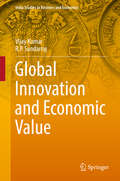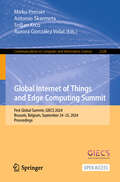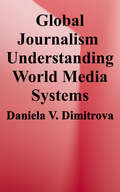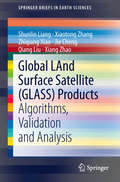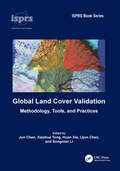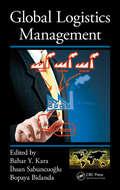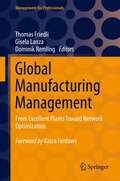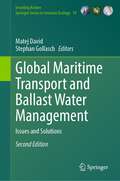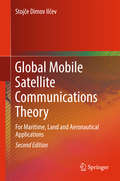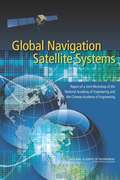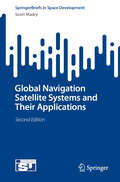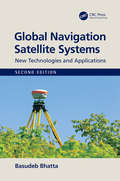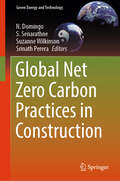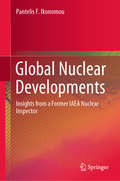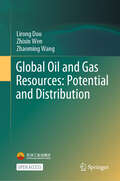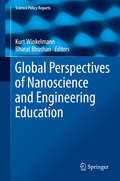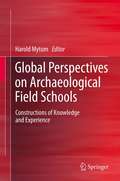- Table View
- List View
Global Innovation and Economic Value
by Vijay Kumar R. P. SundarrajThis book attempts to capture innovation outcomes. The intent is on a holistic assessment of value creation by innovation -- the societal value that it delivers to humanity, the economic value that it has the potential to endow to nations, and the monetary value that it provides to innovating firms. With a range of anecdotal examples and empirical analysis, the book endeavours to answer the question: Have investments in innovation paid off? Big data and analytics underpin the development of the book material. The coverage is truly global, accentuating the economic value created by innovation in the technology and pharmaceutical sectors, the two largest bastions of innovation. In addition, it includes numerous examples of successful innovation in global companies while analyzing its economic/financial impact.
Global Internet of Things and Edge Computing Summit: First Global Summit, GIECS 2024, Brussels, Belgium, September 24–25, 2024, Proceedings (Communications in Computer and Information Science #2328)
by Antonio Skarmeta Srdjan Krco Mirko Presser Aurora González VidalThis Open Access book constitutes the proceedings from the First Global Internet of Things and Edge Computing Summit, GIECS 2024, held in September 24–25, 2024, in Brussels, Belgium. The 12 full papers presented here were carefully reviewed and selected from 21 submissions. These papers have been organized under the following topical sections: Industrial Internet of Things (IIoT) and Digital Twins; Data Management, Privacy, and Trust in Distributed Systems; Edge Computing and Cross-Domain Systems.
Global Journalism: Understanding World Media Systems
by Daniela V. DimitrovaGlobal Journalism: Understanding World Media Systems provides a current and comprehensive overview of the key issues in global journalism in the digital age and traces how media systems have evolved over time in different world regions. With topics ranging from global media freedom and journalistic cultures to foreign news reporting and public diplomacy, conceptual content is presented in accessible style and supplemented by timely case studies.
Global LAnd Surface Satellite (GLASS) Products
by Shunlin Liang Xiaotong Zhang Zhiqiang Xiao Jie Cheng Qiang Liu Xiang ZhaoThis book describes the algorithms, validation and preliminary analysis of the Global LAnd Surface Satellite (GLASS) products, a long-term, high-quality dataset that is now freely available worldwide to government organizations and agencies, scientific research institutions, students and members of the general public. The GLASS products include leaf area index, broadband albedo, broadband emissivity, downward shortwave radiation and photosynthetically active radiation. The first three GLASS products cover 1981 to 2012 with 1km and 5km spatial resolutions and 8-day temporal resolution, and the last two GLASS products span 2008 to 2010 with 3-hour temporal resolution and 5km spatial resolution. These GLASS products are unique. The first three are spatially continuous and cover the longest period of time among all current similar satellite products. The other two products are the highest spatial-resolution global radiation products from satellite observations that are currently available. These products can be downloaded from Beijing Normal University at http://glass-product. bnu. edu. cn/ and the University of Maryland Global Land Cover Facility at http://www. glcf. umd. edu/ The GLASS products are the outcome of a key research project entitled "Generation & Applications of Global Products of Essential Land Variables", supported by funding from the High-Tech Research and Development Program of China and involving dozens of institutions and nearly one hundred scientists and researchers. Following an introduction, the book contains five chapters corresponding to these five GLASS products: background, algorithm, quality control and validation, preliminary analysis and applications. It discusses the long-term environmental changes detected from the GLASS products and other data sources at both global and local scales and also provides detailed analysis of regional hotspots where environmental changes are mainly associated with climate change, drought, land-atmosphere interactions, and human activities. The book is based primarily on a set of published journal papers about these five GLASS products and includes updated information. Since these products have now begun to be widely used, this book is an essential reference document. It is also a very helpful resource to anyone interested in satellite remote sensing and its applications.
Global Land Cover Validation: Methodology, Tools, and Practices (ISPRS Book Series)
by Jun Chen Xiaohua Tong Lijun Chen Songnian Li Huan XieThis book aims to summarize and report the major research achievements and validation results under the global land cover (GLC) initiative led by the Group Earth Observation (GEO). The first part of the book introduces the major tasks and challenges facing the validation of finer-resolution GLC maps and presents the concepts and overall framework of the GEO-led initiative. Chapters 2-5 provide systematic introductions to the major methodology of finer-resolution GLC map validation, including sampling design, reference data collection, sample labeling, and accuracy assessment. Chapter 6 introduces the online validation tools that have been developed, including their design, considerations, and functionalities. Chapter 7 presents the international validation practices and the results of validating GlobeLand30 at country, regional, and global scales. Future directions are also discussed in the Conclusion chapter.Features Presents complete coverage of land cover validation, from concepts, methodology, and col laborative tools to applications. Details algorithms, techniques, and methods for land cover validation, including sampling, judgment, and accuracy assessment. Reviews some of the software tools that can be used for GLC validation and discusses the issues related to the design, usability, efficiency, and limitations of these tools. Highlights case studies of validation at global, regional, and national scales, which can serve as great references for researchers. Provides an extensive bibliography covering the whole scope of land cover validation Global Land Cover Validation: Methodology, Tools, and Practices serves as a reference for those engaged in land cover validation, especially at a global scale, including students, professionals, researchers, and general practitioners. It is also an excellent resource for professionals involved in sustainable development monitoring, environmental change studies, natural resource management, disaster assessment and mitigation, and many other applications.
Global Logistics And Distribution Planning: Strategies for Management
by Donald WatersThe fully revised new edition of this well known and respected book is characterized by the more international perspective it has taken on through contributions from internationally known authors and a final section on international logistics which examines in turn strategies for West and East Europe, the Far East and North America.Logistics has a key strategic role to play in the long-term plans of major companies, and is recognized as a vital part of every organization. To a large extent this crucial new role is due to an expanded view of logistics, which now includes all the activities related to the supply chain from initial suppliers through to final customers.This book provides a wealth of useful ideas and practical information on all the current and future trends in logistics and distribution. Written by a host of contributors drawn from industry, constancy and education, this book provides new insights into the most significant aspects of logistics, including:developments in logisticssupply chain strategieslean logisticsefficient customer responselogistics in different countriespartnering and strategic alliancesre-engineering the logistics functionFrom logistics professionals, consultants, professors and students to managers from different backgrounds who want an appreciation of current trends in the subject, this book is essential reading.About the author: Donald Waters, a past member if the Institute of Logistics and currently a member of the Canadian Association of Logistics Management, has lectured weekly on logistics, operational research and management science, and has brought his academic career to fruition as Professor of Operations Management at the University Calgary, Canada. He is also the author of Operations Management in the Kogan Page Fast Track MBA Series. Features
Global Logistics Management (Industrial Engineering)
by Bopaya Bidanda Bahar Y. Kara İhsan SabuncuoğluGlobal Logistics Management focuses on the evolution of logistics in the last two decades, and highlights recent developments from a worldwide perspective. The book details a wide range of application-oriented studies, from metropolitan bus routing problems to relief logistics, and introduces the state of the art on some classical applications. The
Global Manufacturing Management: From Excellent Plants Toward Network Optimization (Management for Professionals)
by Thomas Friedli Gisela Lanza Dominik RemlingUsing site-specific optimization approaches in international manufacturing networks is increasingly proving insufficient. To solve this problem, several holistic and integrated alternatives have been developed to reflect a global perspective. This book presents advances in the St. Gallen Global Manufacturing Network Model and its application in numerous industry-, benchmarking- and research projects. The contents combine data-driven solutions with qualitative management frameworks for the strategic optimization of international manufacturing networks.In the first part, the book addresses the foundation of manufacturing network management and further describes the St. Gallen Operational Excellence approaches to manage plant performance. On this basis, the authors show how plant- and network-level performance can be enhanced via key improvement domains (e.g., strategy, configuration, coordination, performance management, digitalization). In turn, the second part demonstrates the application of the constructs in manufacturing companies from various industries. By combining research and practice, the book offers unique perspectives on the management of global production striving toward higher performance on manufacturing site and network level.
Global Manufacturing Technology Transfer: Africa-USA Strategies, Adaptations, and Management (Systems Innovation Book Series)
by Adedeji B. BadiruGlobal Manufacturing Technology Transfer: Africa-USA Strategies, Adaptations, and Management presents practical strategies for developing and sustaining manufacturing technology transfers. It is particularly useful for helping developing nations achieve and sustain a solid footing of economic development through manufacturing. The book examines Afr
Global Maritime Transport and Ballast Water Management: Issues and Solutions (Invading Nature - Springer Series in Invasion Ecology #16)
by Matej David Stephan GollaschIn 2015 the first edition of this book was published before the Ballast Water Management (BWM) Convention entered into force. To our knowledge this was and still is the first comprehensive book on BWM worldwide. It provided an overview of possible solutions to the complex issue of BWM. It further outlined consequences and implications to address the ballast water "problem" in line with provisions of the BWM Convention considering environmental, shipping, legal and policy perspectives. The previously addressed subjects remain essential, but new subjects appeared which more recently have proven to be critical for the effective BWM Convention implementation. After the first book content was already agreed and in preparation, new advances were achieved in BWM-related research around the world. Further, new experience was gained and issues came out during the preparation processes of countries for the BWM Convention implementation. The editors of the first book remained heavily involved in BWM-related research and other processes, hence these new critical BWM issues and subjects are now dealt with in the second edition of this book to complement the first one. In essence, this new book covers main issues that arose recently during the implementation of the BWM Convention. Scientists and experts with extensive experience in these subjects from around the globe from academic and private sectors, as well as national administrations, were involved in the preparation of this book.
Global Megaprojects: Lessons, Case Studies, and Expert Advice on International Megaproject Management
by Virginia A. GreimanGLOBAL MEGAPROJECTS The definitive guide to international megaprojects from an undisputed authority in the field In Global Megaprojects: Lessons, Case Studies, and Expert Advice on International Megaproject Management, distinguished international megaproject researcher and consultant Virginia A. Greiman delivers a comprehensive and incisive discussion of a key topic in global infrastructure development: the international megaproject. In the book, readers will find indispensable guidance and insights from experienced megaproject experts, as well as over 20 case studies highlighting practical solutions to common and pressing issues faced by project stakeholders around the world. This book was written to demonstrate that megaprojects can and have accomplished major economic, social, and technical advancements thought impossible but achieved by successfully confronting the challenges of the time. This book offers solutions and prescriptions for megaproject participants to overcome the complex challenges presented by these projects. It incorporates the latest evidence-based theory and a wealth of practical experience and provides a truly international perspective, showcasing viewpoints from a diverse collection of regions, cultures, and industries. Global Megaprojects also presents: Thorough introductions to megaprojects and their lifecycles, including the megaproject ecosystem and the world’s emerging megaprojects In-depth examinations of megaproject finance and economics, including innovation and value-driven program management Extensive explorations of complex project leadership, including the characteristics of uncertainty, complex projects, and cross-cultural dynamics Comprehensive discussions of megaproject implementation management, including global delivery methodologies and strategic objective alignment Global Megaprojects: Lessons, Case Studies, and Expert Advice on International Megaproject Management will earn a place in the libraries of project managers, policymakers, academics, contractors, engineers, suppliers, investors, and sponsors of large international projects.
Global Mobile Satellite Communications Applications
by Stojče Dimov IlčevGlobal mobile satellite communications (GMSC) are specific satellite communication systems for maritime, land and aeronautical applications. It enables connections between moving objects such as ships, vehicles and aircrafts, and telecommunications subscribers through the medium of communications satellites, ground earth stations, PTT or other landline telecommunications providers. Mobile satellite communications and technology have been in use for over two decades. Its initial application is aimed at the maritime market for commercial and distress applications. In recent years, new developments and initiatives have resulted in land and aeronautical applications and the introduction of new satellite constellations in non-geostationary orbits such as Little and Big LEO configurations and hybrid satellite constellations as Ellipso Borealis and Concordia system. This book is important for modern shipping, truck, train and aeronautical societies because GMSC in the present millennium provides more effective business and trade, with emphasis on safety and commercial communications. Global Mobile Satellite Communications is written to make bridges between potential readers and current GMSC trends, mobile system concepts and network architecture using a simple mode of style with understandable technical information, characteristics, graphicons, illustrations and mathematics equations. Global Mobile Satellite Communications represents telecommunications technique and technology, which can be useful for all technical staff on vessels at sea and rivers, on all types of land vehicles, on planes, on off shore constructions and for everyone possessing satellite communications handset phones.
Global Mobile Satellite Communications Theory
by Stojče Dimov IlčevThis book discusses current theory regarding global mobile satellite communications (GMSC) for maritime, land (road and rail), and aeronautical applications. It covers how these can enable connections between moving objects such as ships, road and rail vehicles and aircrafts on one hand, and ground telecommunications subscribers through the medium of communications satellites, ground earth stations, Terrestrial Telecommunication Networks (TTN), Internet Service Providers (ISP) and other wireless and landline telecommunications providers. The new edition covers new developments and initiatives that have resulted in land and aeronautical applications and the introduction of new satellite constellations in non-geostationary orbits and projects of new hybrid satellite constellations. The book presents current GMSC trends, mobile system concepts and network architecture using a simple mode of style with understandable technical information, characteristics, graphics, illustrations and mathematics equations. The first edition of Global Mobile Satellite Communications (Springer, 2005) was split into two books for the second edition - one on applications and one on theory. This book presents global mobile satellite communications theory.
Global Navigation Satellite Systems
by National Academy of EngineeringThe Global Positioning System (GPS) has revolutionized the measurement of position, velocity, and time. It has rapidly evolved into a worldwide utility with more than a billion receiver sets currently in use that provide enormous benefits to humanity: improved safety of life, increased productivity, and wide-spread convenience. Global Navigation Satellite Systems summarizes the joint workshop on Global Navigation Satellite Systems held jointly by the U.S. National Academy of Engineering and the Chinese Academy of Engineering on May 24-25, 2011 at Hongqiao Guest Hotel in Shanghai, China. "We have one world, and only one set of global resources. It is important to work together on satellite navigation. Competing and cooperation is like Yin and Yang. They need to be balanced," stated Dr. Charles M. Vest, President of the National Academy of Engineering, in the workshop's opening remarks. Global Navigation Satellite Systems covers the objectives of the workshop, which explore issues of enhanced interoperability and interchangeability for all civil users aimed to consider collaborative efforts for countering the global threat of inadvertent or illegal interference to GNSS signals, promotes new applications for GNSS, emphasizing productivity, safety, and environmental protection. The workshop featured presentations chosen based on the following criteria: they must have relevant engineering/technical content or usefulness; be of mutual interest; offer the opportunity for enhancing GNSS availability, accuracy, integrity, and/or continuity; and offer the possibility of recommendations for further actions and discussions. Global Navigation Satellite Systems is an essential report for engineers, workshop attendees, policy makers, educators, and relevant government agencies.
Global Navigation Satellite Systems and Their Applications (SpringerBriefs in Space Development)
by Scott MadryProfessor Madry, one of the world's leading experts in the field of the practical applications of satellites and space technologies, provides in a condensed form, a quick yet comprehensive overview of all aspects of satellite navigation. This new edition concisely addresses the latest breakthrough technologies, the various national systems, the many applications, the regulatory issues, and the strategic implications of satellite navigation systems. The future directions of autonomous aircraft and the role drones play in satellite navigation networks are also evaluated. Moreover, the industry's strengths and weaknesses are discussed, as well as reviews of all the various national systems now being deployed. The motivation behind the proliferation of these systems, in this book, evaluates the overall societal and ethical issues of these invisible yet pervasive parts of our modern digital world.
Global Navigation Satellite Systems: New Technologies and Applications
by Basudeb BhattaGlobal Navigation Satellite Systems (GNSS) and their associated technologies have advanced by leaps and bounds in the nine years since the first edition of this book was published. The concept of survey has changed, especially in the disciplines of geomatics and geoinformatics. This revised and updated second edition provides a thorough understanding of the basic principles and techniques of GNSS, analyzes all four active systems, and explains clearly how each of these systems works. Because of its straightforward treatment of the subject, readers will gain an insight into the techniques, trends, and applications of GNSS and develop knowledge on selecting an appropriate GNSS instrument. Written for students and practitioners in geoinformatics, geomatics engineering, surveying, and remote sensing and GIS, this introductory and practical book includes questions and exercises in each chapter. Key Features: • Furnishes detailed information on GPS, GLONASS, Galileo, BeiDou, and other regional and augmented systems• Provides practical guidance for surveying, mapping, and navigation with GNSS• Sheds light on the latest developments and modern trends of GNSS• Includes a detailed glossary of related terms• Contains many illustrations that complement the text• Exercises for each chapter• MCQ, solution manual for mathematical problems, and PPT as online resources
Global Net Zero Carbon Practices in Construction (Green Energy and Technology)
by Srinath Perera Suzanne Wilkinson N. Domingo S. SenarathneThis book covers a spectrum of pivotal topics, including the precise definition and metrics of net zero carbon, the integration of low carbon practices, stakeholder engagement, collaboration on carbon emissions in construction, and building life cycle requirements to achieve net zero carbon. Its importance lies in providing actionable insights and practical knowledge to stakeholders, empowering them to implement effective measures for reducing carbon footprints in construction projects. The target audience for this book encompasses professionals in the construction industry, sustainability experts, policymakers, educators, and students engaged in the fields of architecture, engineering, and environmental studies, who aspire to spearhead positive change in the global construction landscape.
Global Networks
by G. Keith CambronThe telecommunications industry has advanced in rapid, significant and unpredictable ways into the 21st century. Global Networks: Design, Engineering and Operation guides the global industry and academia even further by providing an in-depth look at the current and developing trends, as well as examining the complex issues of developing, introducing, and managing cutting-edge telecommunications technologies. The author draws upon his considerable experience in the telecommunications industry to educate engineers designing equipment and systems on the hardware and software features essential to fault tolerant operation. He describes how to design networks that are fault tolerant and global in scope; how to identify best engineering and operations practices; and examines the role of technology labs in carrier networks. Software and hardware engineering practices are covered in depth. Hardware and software designs are explained with an emphasis on application and interaction of craft and operators with equipment and systems. The author proposes that equipment, systems and network designs should be integrated with the engineering and operations teams that run them. Practice, experience and a historical background are used to describe which designs and technologies fit which network services and applications. Global Networks is a complete and thorough assessment of the communications industry today, written by an author of international renown. Key features: Comprehensive treatment of the key theories and technologies associated with the design of modern communications networks, including equipment, systems and network design Coverage of equipment and software design, mobile networks, integration and the characteristics of large network outages Written in an accessible style and fully illustrated, it offers a complete and up-to-date picture of communications technologies from initial design through to application Includes a section on future challenges such as the Exabyte traffic growth and an assessment of the dual roles of IPV4 and IPV6
Global Nonlinear Dynamics for Engineering Design and System Safety (CISM International Centre for Mechanical Sciences #588)
by Giuseppe Rega Stefano LenciThis is the first book which exploits concepts and tools of global nonlinear dynamics for bridging the gap between theoretical and practical stability of systems/structures, and for possibly enhancing the engineering design in macro-, micro- and nano-mechanics. Addressed topics include complementing theoretical and practical stability to achieve load carrying capacity; dynamical integrity for analyzing global dynamics, for interpreting/predicting experimental behavior, for getting hints towards engineering design; techniques for control of chaos; response of uncontrolled and controlled system/models in applied mechanics and structural dynamics by also considerung the effect of system imperfections; from relatively simple systems to multidimensional models representative of real world applications; potential and expected impact of global dynamics for engineering design.
Global Nuclear Developments: Insights from a Former IAEA Nuclear Inspector
by Pantelis F. IkonomouWritten by a former International Atomic Energy Agency (IAEA) nuclear inspector and nuclear security expert, this book provides a comprehensive and authentic overview of current global nuclear developments. The author provides detailed insights into current and past nuclear crises and reveals the technical capabilities, political strategies and motives of nuclear weapon owners. By analyzing the nuclear programs and strategies of various countries, including the USA, Russia, China, Great Britain and France, this book highlights the existing global nuclear threat and the risks it entails for humanity. It also describes the current blockades and suggests possible ways out. Given its scope, the book will appeal to scholars and policymakers interested in gaining new insights into sensitive or complex nuclear programs in various countries.
Global Occupational Safety and Health Management Handbook
by Thomas FullerThis book was written with the belief that everyone globally has the right to a safe and healthy workplace. An 8-year old carrying bricks in the mid-day sun in Nepal, a pharmaceutical business executive on assignment in Bangladesh, or a mother polishing stone in her home in Tanzania; each has a fundamental right to a workplace free from risk of injury, illness, and death. <p><p> Global Occupational Safety and Health Management Handbook is a broad presentation and discussion of the issues and obstacles facing the Occupational Safety and Health (OSH) profession today in providing safe workplaces globally. Readers can use this book to find resources to assist in the development of their programs and to become informed about the basic structures of international OSH development and governance. Readers can also rely on this book to become more aware of global OSH issues and problems that they may be personally or professionally willing and able to help address. Seasoned OSH professionals can expect to learn about new ways to look at complicated and controversial topics. Young professionals and students can read this book to better understand the important global OSH interrelationships and challenges of the future. <p><p> Features <li>Serves as a one-stop resource for information on important international safety and health topics and issues <li>Provides detailed information about international OSH tripartite, nongovernmental, and professional organizations <li>Describes the various global OSH educational and professional development needs, and international approaches to expanding capacity and awareness of the profession <li>Discusses controversial international OSH working conditions and explains their global impacts
Global Oil and Gas Resources: Potential and Distribution
by Lirong Dou Zhixin Wen Zhaoming WangThis open access book presents the evaluation of undiscovered oil and gas resources and reserves growth in 468 basins around the world, as well as the potential of unconventional recoverable resources of seven types, including shale oil, heavy oil, oil sands, oil shale, shale gas, coalbed methane, and tight gas. The evaluation methods used are innovative, incorporating both conventional and unconventional oil and gas resources evaluation methods that utilize plays as the fundamental evaluation unit based on various exploration maturity levels. The evaluation results obtained independent intellectual property rights and provide an overview of the future exploration potential and prospects of different regions. It is a valuable reference for researchers, practitioners, and students involved in petroleum exploration.
Global Perspectives for Local Action: Using TIMSS to Improve U.S. Mathematics and Science Education
by National Research CouncilThe Third International Mathematics and Science Study (TIMSS) raised the alarm about U.S. mathematics and science education. Most Americans are now aware that U.S. students lag behind their peers in other developed nations. In one state, the legislature reacted by lengthening the school year, assuming that more time on academic content would boost student performance. Some educators have fixed the blame on the mathematics and science curricula typically used in U.S. schools.Does the problem lie in the curricula, instruction, or the system of support available to teachers? This book presents the first comprehensive analysis of TIMSS study--a half-million students from 15,000 schools around the world. It presents detailed reports on three major aspects of education, including curriculum issues, teaching practices, and school support.
Global Perspectives of Nanoscience and Engineering Education
by Bharat Bhushan Kurt WinkelmannThis book presents the perspectives of nanotechnology educators from around the world. Experts present the pressing challenges of teaching nanoscience and engineering to students in all levels of education, postsecondary and informal environments. The book was inspired by the 2014 NSF workshop for Nanoscience and Engineering Education. Since nanotechnology is a relatively new field, authors present recommendations for designing nanotechnology education programs. The chapters describe methods to teach specific topics, such as probe microscopy, size and scale, and nanomaterial safety, in classrooms around the world. Other chapters describe the ways that organizations like NNIN and the NISE Network have influenced informal nanotechnology education. Information technology plays a growing role in all types of education and several chapters are devoted to describing ways how educators can use online curricula for teaching nanotechnology to students from preschool to graduate school.
Global Perspectives on Archaeological Field Schools
by Harold MytumArchaeological field schools, notably in North America but also across the world, are seminal student experiences. They are also important vehicles by which research students and academic staff carry out fieldwork research, often away from the environs of their home institution. Field schools are teaching and research projects, but they also take place within a contemporary local context. This is the first ever collection of studies examining the tensions between teaching, research and local socio-cultural conditions, and explores the range of experiences associated with field schools. It will be of interest to all those wishing to attend a field school, whether as student or junior staff member, and for novice and experienced field school directors who can gain fresh insights from others' experiences.
